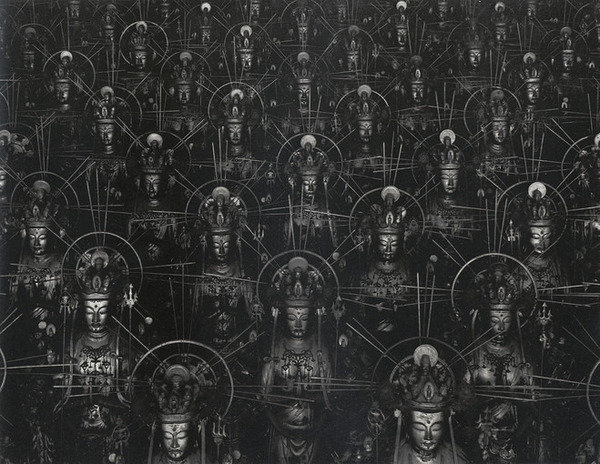Hiroshi Sugimoto
dal 9/10/2013 al 25/1/2014
Segnalato da
9/10/2013
Hiroshi Sugimoto
Fondation Pierre Berge' Yves Saint Laurent, Paris
Accelerated Buddha. the Fondation juxtaposes Sugimoto's artworks with antique masterpieces from his personnal collection. The works include an art video of the thousand Bodhisattva of Sanjusangendo - a 13th century temple in Kyoto - will be presented. A process of accelerated photographs makes us see the thousand Buddhas becoming a million.

curated by Hiroshi Sugimoto / Emmanuelle de Montgazon
On the occasion of its 20th exhibition, the Fondation Pierre Bergé – Yves Saint Laurent gives a carte blanche to Japanese artist, Hiroshi Sugimoto. For Accelerated Buddha, the Fondation juxtaposes Sugimoto's artworks with antique masterpieces from his personnal collection.
The works include an art video of the thousand Bodhisattva of Sanjûsangendo — a 13th century temple in Kyoto — will be presented. A process of accelerated photographs makes us see the thousand Buddhas becoming a million.
Hiroshi Sugimoto is a major figure in contemporary photography who pioneered the use of very long exposure times. His work explores time and man's relationship with reality.
Civilisations rise, spread, and die out. The glories that were Egypt and Greece,
Celtic Europe and the Inca Empire all vanished, leaving but evocative traces
whose spirit was carried forward in part by successive civilisations.
People originally co-existed with their gods. People are thought to have turned
from animals into humans with the emergence of consciousness some five
million years ago. Consciousness brought a heightened awareness of time and
with it special ceremonies for mourning the dead. Death was omnipresent,
or rather death was thought to be a constant universal state and life only an
exceptional transition. The gods existed at the fringes of life and death, and
people spent their brief lifespans preparing for the
journey into eternal death. Nobles commissioned
gigantic tombs for themselves and offered living
sacrifices to the gods.
Then sometime during Neolithic Age, as the
dawn of conceptual thought overtook the
sentient obscurity, the gods were now envisioned
as manifesting themselves throughout the
natural world — in fire, in water, in stone, in
trees, in wolves, in foxes, in the sun and moon.
Perhaps as early as five thousand years ago,
humanity reached the age of civilisation. People
domesticated animals, raised plants and irrigated
fields. Amidst growing self-realisation, they stored
and transmitted their knowledge in writing. History
was born.
People became arrogant in their self-confidence.
The myriad Neolithic gods and spirits gradually
transformed and fused into humanised deities.
People sought out the most spiritually gifted
and bestowed upon them godlike stature. They
abandoned the worship of graven images and
idolised special people instead. The holy men of
Buddhism, Christianity and Islam were elevated to
ever greater heights, which led to bloody sectarian
fighting in the name of religion.
Buddhism grew out the Vedic beliefs of India some two thousand five hundred
years ago as preached by Gautama Siddhârtha, the Sage of Sâkya Clan who
became known as the Buddha or “Enlightened One”. He taught that the world
was full of suffering and that both life and death repeated an endless cycle of
reincarnation, yet we might aspire to escape this wheel of suffering by striving
toward enlightenment. Buddhism later faded away in India, but split into different
schools elsewhere in Asia, the orthodox Theravâda sects remaining to the south,
while the more interpretive Mahâyâna teachings crossed the Himalayas into
China and flourished in Chang-an. By the early sixth century, Buddhism had
reached Japan, where it was established in the seventh century as the national
religion to protect the state built around the imperial lineage.
This exhibition features a video rendering of
a thousand Bodhisattva statues enshrined
in the thirteenth century temple Rengeô-in,
better known as Sanjûsangendô, in
k
yôto.
In five minutes, you will see forty-eight
separate photos of the thousand statues
gradually accelerate and multiply into a
million figures. Rengeô-in was built by the
retired Emperor Go-shirakawa as a visionary
model of Amida Buddha’s Pure Land
Paradise, accelerated here until it dissipates.
Displayed alongside the video, various
Buddhist relics and treasures also provide an
overview of Buddhist thinking throughout the
ages.
As every civilisation speeds toward destruction — and our present civilisation
is no exception to the rule — it should be obvious to anyone that mass
reproduction and economic growth cannot continue forever.
w
e can easily see
ourselves in these r
eplicating Buddha figures, accelerating toward oblivion.
Humankind now approaches the realm of enlightenment, beyond the cycle of life
and death.
Hiroshi Sugimoto
PRESS AND COMMUNICATION DEPARTMENT
Fondation Pierre Bergé – Yves Saint Laurent
Laetitia Roux – Tel. +33 (0)1 44 31 64 17
l.roux@fondation-pb-ysl.net
Olivier Flaviano – Tel. +33 (0)1 44 31 64 19
o.flaviano@fondation-pb-ysl.net
Fondation Pierre Berge' Yves Saint Laurent
3 rue Léonce Reynaud, 75116 Paris
Open from Tuesday to Sunday, except public holidays from 11 am to 6 pm (last entry at 5.30 P.M.)
Full price 7€ Reduced price 5€ for students, people under 25 and seniors
Free for children under 10 and job-seekers



